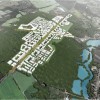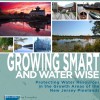Land Preservation
New Jersey ranks as a national leader in land conservation, through popular state and local programs to preserve farmland and open space. In round numbers, more than one-fourth of our state is publicly owned or deed-restricted parkland or farmland. Yet suburbanization spreads further into the open countryside every day, threatening water supplies, fragmenting woodlands and wildlife habitats and “checker-boarding” farming areas. Some analysts have estimated “build out” of New Jersey’s remaining buildable land in 30-50 years.
Our state’s land conservation programs can be made more efficient and effective by integrating the purchase of land with land-use planning and regulation, infrastructure investments and tax policy. Transfer of development rights (TDR) and clustering, in particular, have the potential to preserve significant amounts of land at little or no public cost, provided they are made easier to use. Only by coordinating all of our tools can we achieve an interconnected, regional web of open and healthy recreational areas, ecosystems, wildlife habitats, water supplies and agricultural land, along with easy access to healthy neighborhood parks.

“Lenape means ‘the original human’, and that is where we need to get back to,” Chief Vincent Mann expressed, adding, “[reconnecting with the land] would provide us a way to encourage the people of tomorrow to take what we are sacrificing to create for them to further the future.” Indigenous people have a rich history of interacting in harmony with the environment.

“It is necessary to invoice Venus’s story, not only through black history, but through Latinx history and queer history. It is too important to excavate this kind of history, so what happened to Venus won’t happen again because it continues to happen.” expressed Michael Roberson, Professor, New School and Union Theological Seminary at the 2023 Planning and Redevelopment Conference hosted by the New Jersey Chapter of the American Planning Association and New Jersey Future.

Recently-released 2015 land use/land cover data from the Department of Environmental Protection offer an opportunity to assess the state of land development in New Jersey.

A group of 18 mayors and organizations concerned with how New Jersey grows and develops has sent a letter to Gov. Murphy urging him to renew focus on the State Plan.

Second of a series of articles detailing strategies coastal states are examining in order to plan for sea-level rise. This article addresses ways to redirect development away from vulnerable areas.

The Economic Opportunity Act of 2013 included additional incentives for projects destined for “smart-growth” areas. This report analyzes how effective the updated incentives have been at directing growth to those areas. December 2014.

Development in the Pinelands growth areas has affected water resources and will continue to exert pressures going forward. This report highlights what can be done by municipal, regional and state agencies to minimize their negative impacts. July 2014.

A redevelopment of a landmark downtown building; several projects designed to spur homeownership in historically disinvested areas; an urban farm; and a bold resiliency plan are the winners of New Jersey Future’s 2016 Smart Growth Awards. Al Koeppe is the recipient of the Cary Edwards Leadership Award.

A redevelopment of a historic urban park; the expansion of an anchor institution in our capital city; a “complete” redesign of a major urban street; a landmark multi-use building that serves as a community anchor; two plans to revitalize neighborhoods near transit; and a pioneering collaborative effort to improve urban neighborhoods prone to stormwater flooding are the winners of New Jersey Future’s 2015 Smart Growth Awards. Anne S. Babineau Esq. wins the Cary Edwards Leadership Award.

Three types of housing developments; two plans to revitalize fading downtowns; an industrial riverfront transformed into an urban asset; a project that will serve as an anchor of hope to its community; and a regional plan for smart economic growth are all winners of New Jersey Future’s 2014 Smart Growth Awards. Joe Maraziti Jr. Esq., receives the Cary Edwards Leadership Award.
See all New Jersey Future Blog posts and articles in this category »
Reports, Presentations and Testimony
- 08/06/2019: Comments on Solar Siting Element of Energy Master Plan
- New Jersey Future Non-Contiguous Cluster Report August 2017
- New Jersey Future report to NJDEP re Liberty State Park 02-04-15
- Economic-Opportunity-Act-and-Smart-Growth-Progress-Report
- PINELANDS_WEB_8_4_14-1
- New Jersey Future Van Abs 2014 Pinelands Growth Area Water Assessment
- NJFuture Cluster Presentation I Open for Municipalities
- How Clustering Works
- Clustering-Factsheet_11_5_2013
- Cluster-Development-Act-summary-of-key-provisions-10-13
- Somerset County Investment Framework 1-13 (Intern Report)
- 05-2009 Smart Housing Incentives Act - Summary
- Case Studies of Non-Contiguous Clustering in New Jersey 04-12
- Cluster Presentation - NJ Farm Bureau 1-4-2012
- Route 1 Planning Through Partnerships
- Case Studies in Transfer of Development Rights 8-10 (Intern report)
- Transfer of Development Rights Task Force Report 08-11-10
- APA-NJ Non-Contiguous Clustering 3-08
- Municipal Resource Conservation Assessment 06-01
- Case Study Hopewell Township 08-00
- Achieving Genuine Prosperity 04-01
- Rethinking Farmland Preservation in New Jersey 05-01
- Presentation: The Status of Transfer of Development Rights in New Jersey 12-10
- Presentation: Land Preservation Using Off-site Clustering 03-19-11
- Transfer of Development Rights (Updated) 05-04
- Smart Conservation: The "Green" Side of Smart Growth
- Race to the Middle: The Homogenization of New Jersey's Population Density
- Getting to Work 11-08











